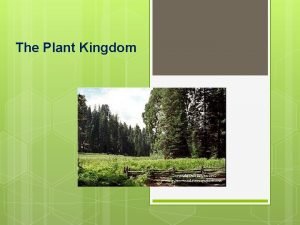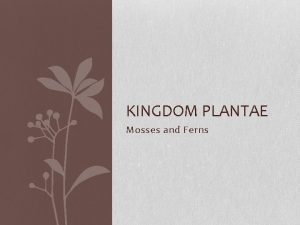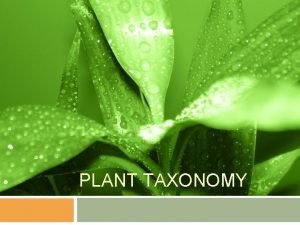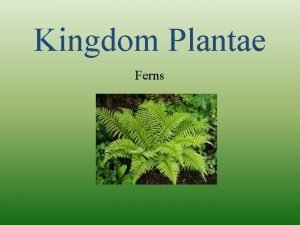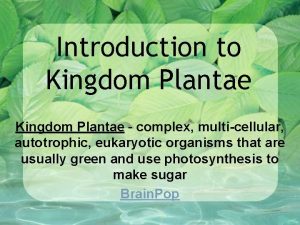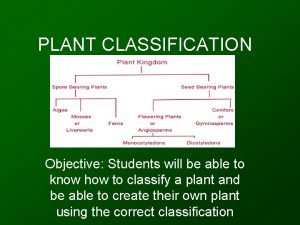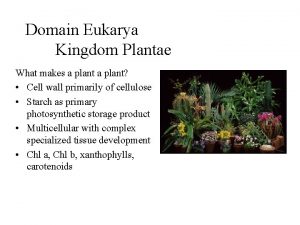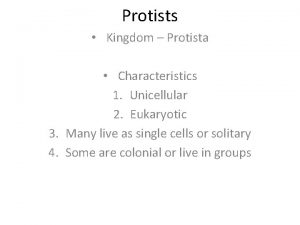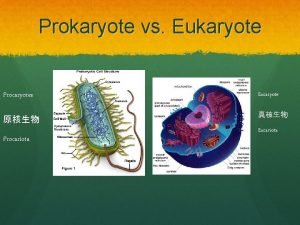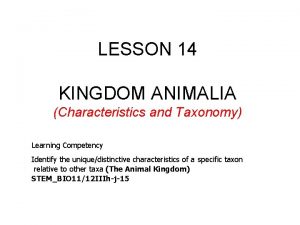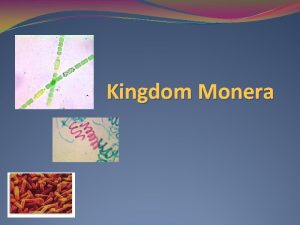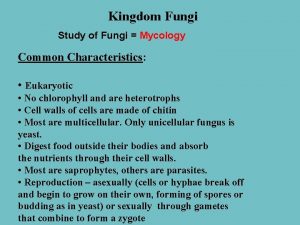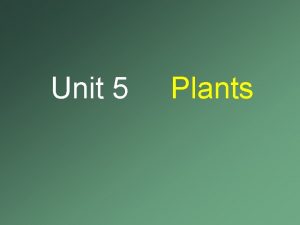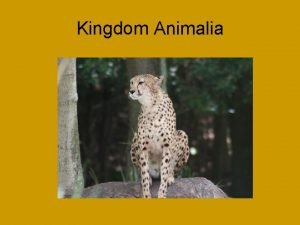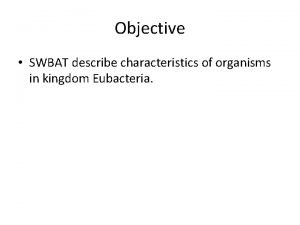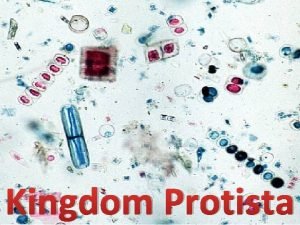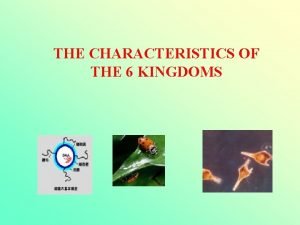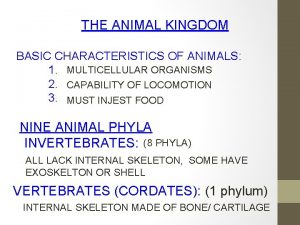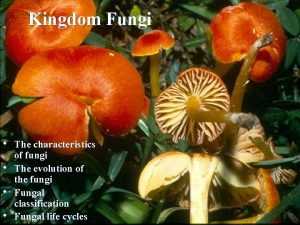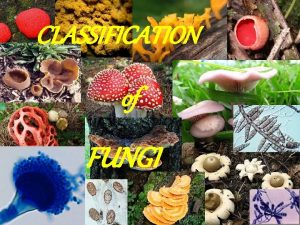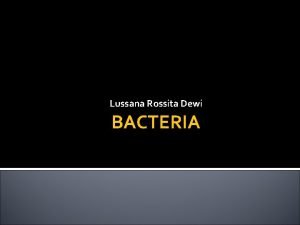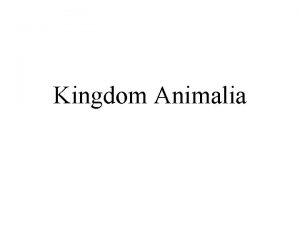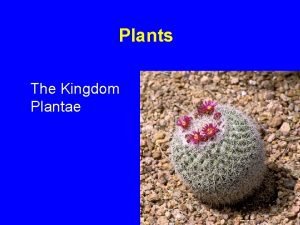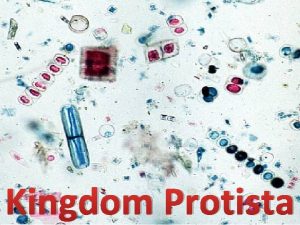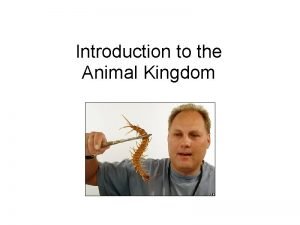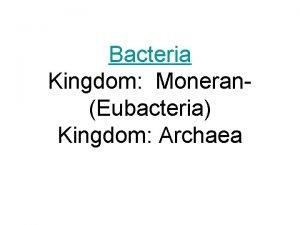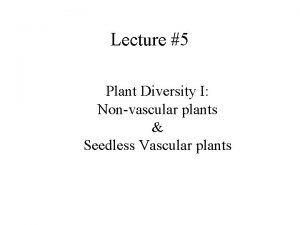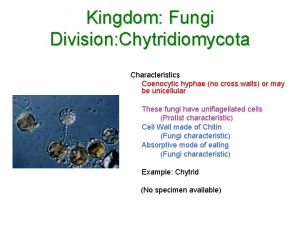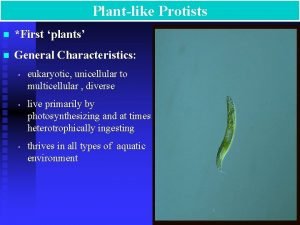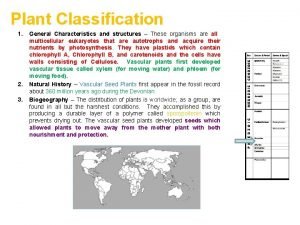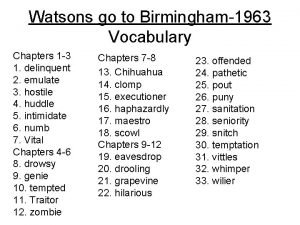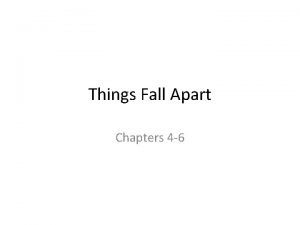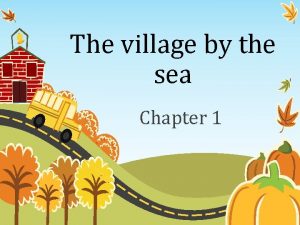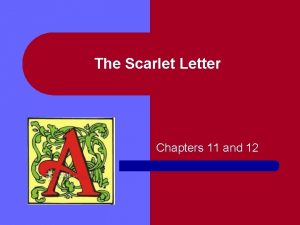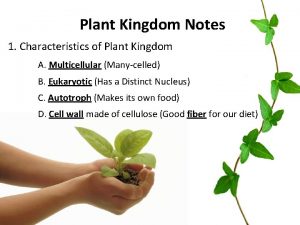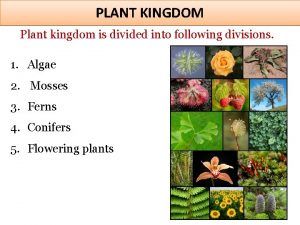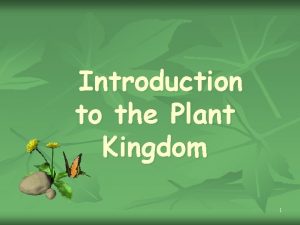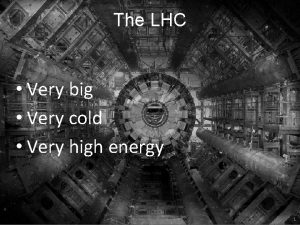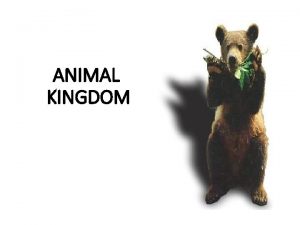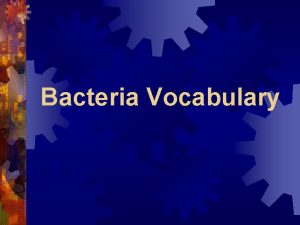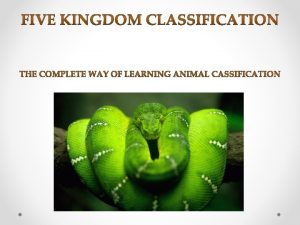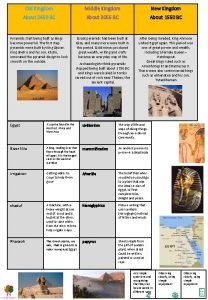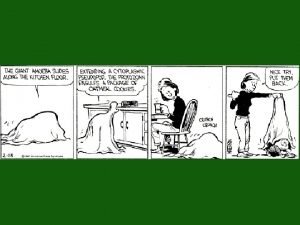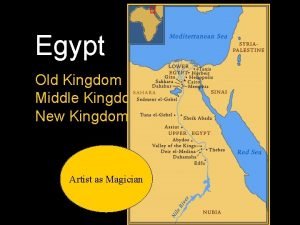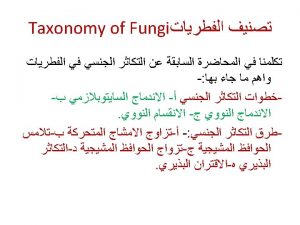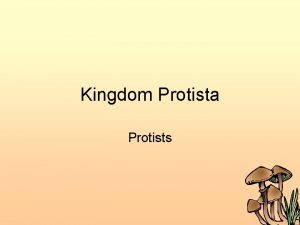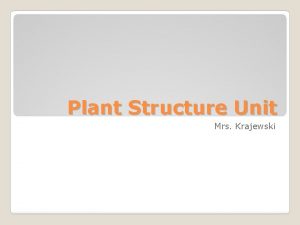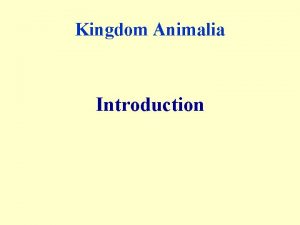Plant Kingdom Chapters 24 27 Plant Characteristics Very


















































































- Slides: 82

Plant Kingdom Chapters 24 - 27



Plant Characteristics Very diverse Autotrophic – use photosynthesis to make food Multi-cellular Eukaryotic type cells Successful on land: absorb nutrients, prevent dehydration, reproduce on land.

Adaptations of Plants Be able to live on land: – Roots: with mycorrhizae - Reproduction on land: pollen carries sperm - Vascular tissue – transport water – Prevent water loss: Cuticle – waxing layer on leaves Stomata – pores in leaves that allow for gas exchange

Stoma

Plant Life Cycle Called alternation of generations Two generations: – Gametophyte (n) – gamete producing stage – Sporophyte – spore producing (2 n),

Example of alternation of generations

Ex. Of alternation of generations 2 Meiosis Sporophyte (2 n) gametophyte

Kinds of Plants 1. 2. Have a cuticle and stoma Nonvascular plants No Seeds Lack vascular tissue that transports water and nutrients. Examples: mosses, liverworts, hornworts


Liverworts No cuticle or stomata, no cells to transport water

Hornworts Have a stoma and cuticle

Seedless Vascular Plants 2. Ferns – Produce spores – Has vascular tissue (simple) sprorophyte

Fern gametophyte

Seed Plants Advantages of Seeds – Consists of an embryo – Contains a supply of food – Protection of embryo – dispersal – Squeege

Cycads Only in tropics and subtropics Separate male and female plants Not a palm tree!!


2. Ginkgo Male and female plants Only 1 species around today



3. Gymnosperms Seeds develop in a cone “naked seeds” No fruit or flowers Successful: – Seeds – Wind pollination – Examples: conifers

4. Angiosperms Flowering plants “case seed” – seeds contained in a fruit. Flowers attract pollinators such as insects, birds, …

Types of Angiosperms Monocots – One seed leaf – Flower parts in multiples of 3 – Leaves with parallel veins

Angiosperms : Dicots – 2 seed leaves – Flower parts in multiples of 2, 4, 5 – Leaves with branching veins

Flower Parts Use your handout to label the parts of the flower.

Flowers attract See the “bull’s eye” ?



How do Bees see?

Looks like a landing pad!!

Sexual Reproduction Male gamete – pollen Female gamete – ovule Pollination – transfer of pollen to structures that contain ovules Fertilization leads to seed formation

Seed Parts (after fertilization) Seeds contain embryos Seed coat: outer layer, for protection Endosperm – food for embryo Cotyledons – seed leaves, help in transfer of nutrients

hilium

cotyledon plumule Embryo

Embryo Parts 1. Plumule – first shoot 2. Epicotyl – pushes new stem above surface 3. Hypocotyl – just below epicotyl 4. Radicle – primary root

epicotyl hypocotyl


Fruits – Ripened Ovary Purpose: Seed Dispersal Two Types: Fleshy – Dry -

Simple Fruits

Multiple Fruit






Chapter 26 Plant adaptations to land.

Tissue Types in plants 1. Dermal tissue – protective outer layer, waterproof Ex. Epidermis – skin on non-woody plants Ex. Cork – “skin” of woody stems and roots Found in leaves, roots, stems

2. Ground Tissue Found on the inside of plants Functions: – A. Leaves – photosynthesis – B. Roots/stems – storage of water, sugar, starch

3. Vascular Tissue Function – conducts water, minerals, and sugars throughout plant Two types of: – 1. Xylem – 2. phloem

a. Xylem Vascular Tissue Transports water and minerals from roots to leaves

b. Phloem Vascular Tissue Transports sugars

Plant Structures Roots, Stems, Leaves

A. Roots Function: anchor, absorb water and minerals, storage Types of roots: – A. Taproots – – B. Fibrous roots -

Roots Root cap – area of growth (apical)Meristem growth tissue Root hairs – for absorption

Cross Section of Roots Vascular tissue in middle. (xylem and phloem) Cortex – storage of starch Epidermis -

Monocot Root Dicot Root

Root Cross Section

Stems Function: support and transport Two types of stems: – Herbaceous stems: flexible and green Vascular bundles: xylem and phloem Pith – ground tissue Cortex – epidermis tissue.

Monocot Dicot


Woody Stems Examples: trees, shrubs Heartwood – wood in the center (old xylem) Sapwood – outside of heartwood, functioning sapwood


Cross section of stem woody Pith – storage tissue Xylem – trans. Water Phloem – trans. Sugar Cortex – storage Bark – cork (young trees and phloem

Growth rings: Spring xylem – Summer xylem -




The Leaf Site of photosynthesis Petiole – attaches leaf to a stem Simple leaf – one blade Compound leaf – two or more leaflets

Simple Leaf –single blade

compound leaf

Compound Leaf

- Alternate Whorled - Opposite

Opposite

Leaf Anatomy Upper and lower epidermis – protection – Cuticle – waxy layer, protection – Guard cells- control opening of the stoma – Stoma – opening on the epidermis for gas exchange.

Leaf anatomy Mesophyll – photosynthesis – Spongy – bottom of leaf, gas exchange – Palisade layer – photosynthesis Vein – xylem and phloem

Pine Needle cross section

Transpiration A. Transport of water Transpiration – loss of water from plant Pulling of water in xylem (cohesion) Osmosis – water to root

Stomata Function Refer to handout. Computer Lab: Chapter 21 -2


Plant Growth Primary Growth – increases length or height of a plant. – Apical meristems – located at tips of stems and roots

Secondary Growth in girth or width Growth tissue: – Cork cambium – in bark, produces cork cells – Vascular cambiumlies under bark, produces vascular tissue
 Old kingdom middle kingdom new kingdom
Old kingdom middle kingdom new kingdom Old kingdom middle kingdom new kingdom
Old kingdom middle kingdom new kingdom Youtube
Youtube Old kingdom middle kingdom new kingdom
Old kingdom middle kingdom new kingdom Plant kingdom characteristics
Plant kingdom characteristics Mosses characteristics
Mosses characteristics Figure 10
Figure 10 Scientific notation rules
Scientific notation rules Few fewfewf
Few fewfewf Is a very shallow skillet with very short sloping sides
Is a very shallow skillet with very short sloping sides Quantifiers for milk
Quantifiers for milk Protista mobility
Protista mobility Plantae kingdom drawing
Plantae kingdom drawing Domain of kingdom protista
Domain of kingdom protista The odds and ends kingdom
The odds and ends kingdom Sugar maple phylum
Sugar maple phylum Main characteristics of plantae
Main characteristics of plantae Fern kingdom
Fern kingdom Plantae multicellular
Plantae multicellular Archaebacteria protista fungi plantae animalia
Archaebacteria protista fungi plantae animalia Plant classification
Plant classification Plantae domain
Plantae domain Archaebacteria cell type and description
Archaebacteria cell type and description Protista ex
Protista ex Procaryote vs eucaryote
Procaryote vs eucaryote Site:slidetodoc.com
Site:slidetodoc.com Mammals characteristics
Mammals characteristics Domain bacteria characteristics
Domain bacteria characteristics Mostly multicellular
Mostly multicellular Kingdom bacteria characteristics
Kingdom bacteria characteristics Spores of fungi
Spores of fungi Yeast kingdom
Yeast kingdom Xylem tissue
Xylem tissue Plantae kingdom characteristics
Plantae kingdom characteristics Characteristics of animalia
Characteristics of animalia Sac fungi domain
Sac fungi domain Eubacteria kingdom characteristics
Eubacteria kingdom characteristics Nutrition in protists
Nutrition in protists Types of phylum in animal kingdom
Types of phylum in animal kingdom Characteristics of animals kingdom
Characteristics of animals kingdom Evolution of fungi
Evolution of fungi Ainsworth classification of fungi slideshare
Ainsworth classification of fungi slideshare Characteristics of kingdom protista
Characteristics of kingdom protista Plantae is unicellular or multicellular
Plantae is unicellular or multicellular What kingdom are true bacteria in
What kingdom are true bacteria in Characteristic of an animal
Characteristic of an animal Common characteristics of plants
Common characteristics of plants Kingdom protista characteristics
Kingdom protista characteristics Anamalia characteristics
Anamalia characteristics Kingdom bacteria characteristics
Kingdom bacteria characteristics Define plant breeding
Define plant breeding Plant introduction in plant breeding
Plant introduction in plant breeding Plant introduction in plant breeding
Plant introduction in plant breeding Tronsmo plant pathology and plant diseases download
Tronsmo plant pathology and plant diseases download Tronsmo plant pathology and plant diseases download
Tronsmo plant pathology and plant diseases download Tronsmo plant pathology and plant diseases download
Tronsmo plant pathology and plant diseases download Characteristics of a vascular plant
Characteristics of a vascular plant Coenocytic hyphae
Coenocytic hyphae Pyrrophyta characteristics
Pyrrophyta characteristics Staminate cone labeled
Staminate cone labeled The watsons go to birmingham vocabulary chapters 1-3
The watsons go to birmingham vocabulary chapters 1-3 Tuesdays with morrie discussion questions
Tuesdays with morrie discussion questions The catcher in the rye chapter 6 quotes
The catcher in the rye chapter 6 quotes To kill a mockingbird chapter 1 quiz
To kill a mockingbird chapter 1 quiz Chapter questions for to kill a mockingbird part 1
Chapter questions for to kill a mockingbird part 1 To kill a mockingbird chapters 9-11 summary
To kill a mockingbird chapters 9-11 summary Chapter 4 summary of to kill a mockingbird
Chapter 4 summary of to kill a mockingbird To kill a mockingbird 28-31 summary
To kill a mockingbird 28-31 summary To kill a mockingbird chapter 27-31 summary
To kill a mockingbird chapter 27-31 summary Chapter 22 questions to kill a mockingbird
Chapter 22 questions to kill a mockingbird What happened in chapter 12 in to kill a mockingbird
What happened in chapter 12 in to kill a mockingbird To kill a mockingbird chapter 10-11 summary
To kill a mockingbird chapter 10-11 summary Tkam chapter 1-5 quiz
Tkam chapter 1-5 quiz Summary of chapters 1-4 of to kill a mockingbird
Summary of chapters 1-4 of to kill a mockingbird Infallible definition to kill a mockingbird
Infallible definition to kill a mockingbird Things fall apart 4-6
Things fall apart 4-6 Chapter 17 things fall apart quotes
Chapter 17 things fall apart quotes Ang ang chapter 14
Ang ang chapter 14 Portia nelson autobiography in five short chapters
Portia nelson autobiography in five short chapters The village by the sea chapter 1
The village by the sea chapter 1 Scarlet letter chapters
Scarlet letter chapters The reluctant fundamentalist summary chapter 3
The reluctant fundamentalist summary chapter 3 The reluctant fundamentalist chapter 7 summary
The reluctant fundamentalist chapter 7 summary




